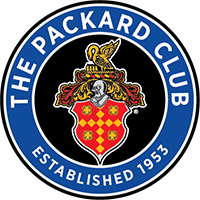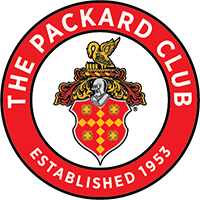The Packard Truck Organization
(A Region of The Packard Club)
Packard Truck Organization
The Packard Truck Organization is a growing group of enthusiasts with a special love of Packard Trucks. It takes a special breed of enthusiasts to bring these gentle giants of the road back to life, and from the photos of their Packard Trucks in the showroom, they do an outstanding job!
Each year, after the Fall Hershey meet, all Packard Truck enthusiasts all converge at the home of Dave Lockard, founder of the Organization, in York Springs, Pa. (about 30 min from Hershey). Dave and his family host the Packard Truck Meet at their home in the country. All Packard owners and truck enthusiasts are invited to attend this wonderful meet on Sunday, immediately following the AACA Fall Hershey Flea Market and Meet. Dave has ample signs pointing the way on Route 15 South from Camp Hill. Each sign is marked "Packard Trucks" and has how many miles until the turn off from Route 15. All are welcome! You will will be able to see the progress of all the hard work on the US Army Truck that is being restored. See you there!
The "Packard Truck Organization" is the quarterly newsletter and annual Dues is $8. dollars.
Contact a representative of The Packard Truck Organization in any of the following methods:
- Email: [javascript protected email address]
- Mail: The Packard Truck Organization
c/o David Lockard
1196 Mountain Rd.
York Springs, Pa. 17372 - Tel: 717-528-4920
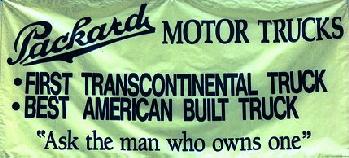
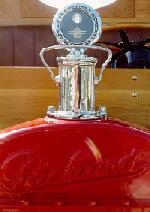
Current Restoration Project
The current restoration project undertaken is a 1918 Model E US Army Truck being restored for the Citizens Motorcar Company, America's Packard Museum, Dayton, Ohio, a non-profit corporation [501(c)(3)]. Making your donation to assist with the restoration is fully tax deductible. For more information, contact [javascript protected email address] or America's Packard Museum. Restoration of these trucks involves great sacrifice in time and money. Due to the comitted Packard enthusiasts who have graciously donated their time and money, a lot of progress has been achieved! (See photos below.) We invite you to join The Packard Truck Organization and also consider helping by donating your experience, time or monies to restore these gentle giants of the road back to life. Your help is needed now to assist funding of the wood body, canvas top, banners, new radiator honeycomb, WW I era hardware for the truck body and to purchase specially made solid rubber tires. (it's all tax deductible)
Restoring a 1918 Packard Army Truck
by Dave Lockard, President & Editor
The Packard Truck Organization
28 Sep 2005
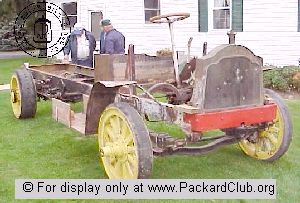
2003
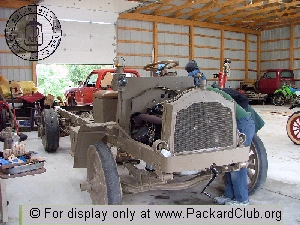
2005
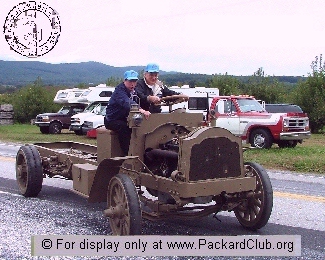
First Time Driven on 09 Oct 2005
IN THE BEGINNING...
The origins of (me) wanting a World War I Packard truck go back to the late 1950's and 1960's in suburban Philadelphia where I grew up. I listened intently (but sadly not often enough) to my next door neighbor Lester Lighton in Glenside, PA who was a volunteer motorcycle messenger 'Dispatch' rider for the Free French Army in 1916. Another local direct source of historic inspiration was the owner of a restaurant where I worked. I relished listening to Joe 'Pop' Conti who began his culinary career as an Army cook behind a horse drawn wagon in 1918 feeding 'American Expeditionary Forces' in France. He related to me how the troops slogged through the unmerciful muck (and) rutted paths and disease ridden terrain that made up the Western Front. Upon returning from the war in 1919, Joseph Conti began his restaurant and gave dining rooms the names of famous battlefields such as the Lorraine Room.
Little did I know that later in my life I would have the distinct privilege of working with many talented automotive friends who shared the sheer love of history (I confess at this point that I am a 'sledge hammer' mechanic) to recreate a Packard of the Great War. My sole heartfelt wish in doing this project is to honor the sacrifices of Americans and Canadians from the World War I conflict by assembling an authentically reproduced running example of a 3-ton Packard Army truck. This truck had to be more than a static museum example of a truck of the era. But I am ahead of myself.
I purchased my Packard truck, a 1920 Model E, Size D truck in 1979. I can honestly blame my wife for this radical deviation from an otherwise normal 'car' hobby. (I still have an all original condition 1952 Studebaker Commander I bought in 1968 from the original owner). My wife, you see, told me of the Packard truck being for sale from an acquaintance at her work. Only after building an addition to my country barn in 1980 could I bring the Packard truck home. I also learned shortly after purchasing my Packard of two Packard parts trucks in Lancaster, PA that I also brought home. Looking like a repository for expired Packard trucks, my wife asked me "What are you going to do now?" I had no idea. "And if they are so rare, how come you have three?"
Fortunately, I was contacted by the Goodyear Tire and Rubber Co shortly after buying the two Packard parts trucks. Goodyear was in the process of restoring a similar Packard truck and was in desperate need of parts. The Goodyear 'Wingfoot Express' was a 1917 pioneer in heavy truck travel on the Lincoln Highway using air filled tires. Trucks of the turn of the century typically had only local use due to solid tires and top speeds of about 10 to 17 miles per hour. Goodyear wanted to prove that the long haul heavy truck was possible with air filled tires and had begun their own trucking company to prove their point.
With the passing of 8 years and with a lot of help from Goodyear as well as my friends did I manage to reactivate a moribund Packard truck and finally drive it out of my garage! It is difficult to describe the feeling of taking a truck from a neglected pile of rusted steel to a running vehicle representative of an early era.
My 1920 Packard one and a half ton truck was acquired in 1979 from 80 year old Ralph Gery whose brother was killed in France in the closing days of the war in November 1918. (Pennsylvania residents may recognize the name of the brick company Glen-Gery. Ralph's father started Glen Gery Brick in the 1800's.) Ralph had located the Packard in the 1930's because of the connection between Packard, his brothers' death, and the Great War. Packard was a major supplier of trucks to the U.S. Army (over 10,000 units), and in 1915 Packard Motor Car Company sold more trucks than cars. Countries such as France, England and Russia bought Packard trucks due to a severe shortage of military transportation equipment in Europe. This was another reminder about the current day need for a WWI Army Packard.
One must remember that owning a Packard truck is not a simple 'hobby'. To get used to a heavy duty 'hobby' that is diametrically opposed to the graceful lines and beautiful nickel plating of, say a twin six Packard, is a totally different experience from the norm. I could never be charged with conformity so Packard trucks were a shoe-in for me. When Packard trucks were not selling well after WWI, dealers were allocating cars based purely on truck sales, and dealers deeply resented this arrangement. A slow selling and ungainly behemoth truck next to a upper crust Packard touring car on a dealer's parking lot or showroom did little for dealer satisfaction. Disdain to this day for Packard trucks has still not gone away entirely as I shared with a Packard Club member once that I had a Packard truck - he replied "I'm sorry to hear that!" Such is life. I'm having fun!!
When I was still looking to find some Packard truck parts that are difficult to obtain such as the brass thumb screw battery box hold downs for my 1920, I had the pleasure of meeting Grover Swank who worked for Winross Restorations, a division of Winross, Inc. of Palmyra, NY. Grover was the parts chaser and field man for the restoration division. Grover had called me and asked if he could get dimensions off my truck for some critically missing parts for a Packard truck Winross was restoring.Grover was a true gentleman; he ate dinner with us, and we sat until late in the evening talking Packard and old vehicles in general when we should have been in the barn measuring my Packard. Grover informed me that Winross had cast the impossible to find brass thumb screw hold downs for the battery box and he would gladly send me a set.
Little did I know when I bid my new friend Grover farewell late that night as he headed to Wilkes-Barre for his sister's home that I would never see him again. Grover succumbed shortly of cancer only months after our initial and only visit.
To his honor, Grover was a 'Pack Rat' which to me is a very endearing trait (as I am a devout 'PR' too). When Winross Restorations completed their Packard truck, Grover and his son Lance Swank dragged the no longer needed left over Packard truck parts to their home in Palmyra, NY. Not knowing of Grover's death, I continued to send him the Packard truck newsletter our 'staff' (me) creates in York Springs quarterly. Sometime later Grover's son Swank called me asking me not to send the newsletter to his Dad's old address as it was upsetting to his wife but wanted the newsletter sent to him. It was then that I told Swank of my idea to create a WWI Packard Army truck. Swank suddenly became quiet and softly murmured "That's what my Dad wanted to do." It was 1997. I contacted the Citizen's Motor Car Company in Dayton, Ohio a 501 (c) (3) non profit organization and asked them what their thoughts were on my taking this project on. Bob Signom who is Counsel to the museum was ecstatic so I agreed to make the Packard Army truck a truck for all time and owned by the museum. The truck is not mine but I agreed to be a lifetime curator, take the truck out and around for the princely sum of zippo, nada, zero. This sum was also what I agreed as an annual stipend.
We acquired a complete Packard frame and drive train from a generous donor, Don Meltz, of Hudson, NY, along with the Packard truck parts Grover and his son had saved. Dave Bennett, owner of Bennett Construction in Salisbury, MD provided a truck and flat bed trailer to transport the parts to my home in York Springs for sorting and ultimate refinishing and final assembly work.??? A closer examination of the Packard frame and driveline from Don Meltz revealed a much deteriorated and twisted frame so consequently a new frame, not an easy acquisition was now needed.
Ron Cary, of Calgary, Alberta, Canada, a supper guy and an old truck aficionado had a very good 3-ton frame so we entered into discussion to obtain this frame that also had very good wooden wheels with solid tires. An attractive price was arrived at and Ron graciously also arranged to have the frame and wheels shipped directly to my home! After a minimal amount of money was paid (at no interest and at no specified interval, Ron Cary told me to stop paying for the frame and wheels and put the money toward the restoration and made the frame a donation! Who said there are no more good people left in the world? The only 'short coming' of the frame was that 24 inches was cut off the rear for some unknown reason. Wolfe Steel of Middletown, PA donated the needed 6 inch channel iron and professional welder Paul Kenific of Salisbury, MD drove the four hours to York Springs and did the much needed welding as a volunteer.
Meanwhile, master machinist Clyde Walters of Canton Ohio volunteered his irreplaceable talents and went over the engine.
Upon learning of the lack of an electric starter for the Army truck, Tom Schlarb of Topton, NC made an electric starter, delivered and installed it (an 11 hour trip one way from Topton, NC to York Springs, PA) and later made a return trip in 2004 to install the starter!
We were able to afford the services of a professional sand blaster to blast the frame, and I enlisted Chris Kessel of nearby Gardners, PA to sand blast the wheels and paint the frame.
This was the progress as of October 2003. As winter set in, little got done on the Packard, so the truck sat until about April 2004.
In 2004 we enlisted (yes, 'volunteered' Army style) craftsman Dave Jacoby of York Springs to make an oak seat and running boards, a very talented machine shop, LL Brown, of Enola, PA to make the special tapered bolts for the 'Thermoid' flex joints for the drive line, and began the task of assembly. Fortunately for 2004 I have a slightly larger shop to do the work in (I spent my inheritance from my late mother, Alma Lockard.). A race was on to have this truck mechanically assembled and maybe running (?) for the upcoming Packard Truck Meet on October 10th, 2004.
Until this time I have purposely not mentioned my good friend Charlie Linus of York Springs who has been my spark plug for this project. Charlie is a retired truck driver and, well, I hate to admit it publicly, but Charlie is a Ford man. Why we get along is still a mystery, but it may have to do with the fact that Henry Ford had his last ride in 1947 in Packard hearse and that Henry also owned a Packard touring car. Apparently Henry Ford had a previously undisclosed good taste in fine automobiles. Charlie Linus is not afraid to lift a wrench, crawl under the truck, or do any needed volunteer work. He has been of unimaginable value to keep me on track for this project. I often fall asleep with my laptop doing my work (I work out of my home) in my La-Z-Boy defending my 'inaction' as laptop work I needed to do for my job - Charlie knows better and mercilessly rousts me out of my La-Z-Boy and literally drags me down to the 'shed'!
The week of Hershey 2004 came all too quickly, and I was not able to make it to Hershey until Saturday for the vehicle show with my 1920. Two unwitting Australian friends staying with me for Carlisle Swap Meet and Hershey got 'volunteered' for some Army truck final assembly in Dave's forced labor camp. Hee…hee…hee. Brothers Dick and Bruce Rowe were probably glad to head back down under as I had chained them to the Packard until their assigned work was done!
Except for a dead magneto and a carb that kept flooding and leaking, we were successful in our assembly efforts for our October 10th deadline but could not start the truck. Packard Club Webmaster Marshall Katz gave us the funds to get the magneto rebuilt at our truck meet so that's about where we are now. The magneto was done later in November 2004.
I have the War Dept plans for the wooden body and hope to do some fundraising in 2005 to buy the wood and get the iron hardware made up as well as obtain the canvas for the bed and driver's area. The radiator needs new honeycomb guts and we have no WW1 era hardware for the truck body. Also, we need banners and specially made solid rubber tires. (it's all tax deductible)Can you help?
Why don't you stop by with a thick wallet (it's all tax deductible) or time to volunteer - we'll find something to assign to you to do! I'm right off Rt US 15 between Harrisburg, PA and Gettysburg, PA. Come on down!!!! The best time to stop by is Sunday after Hershey when we have our annual Packard Truck Meet. Drive any model vehicle to the meet, but by all means, we would love to have you attend. Packard Truck rides for "kids" of all ages.
Dave...
The TRAIL of the LONESOME TRUCK
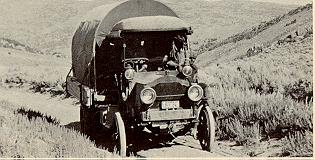 The Trail of the Lonesome Truck is the unprecedented journey of the first heavy-duty motor vehicle to cross the continent on its own power as documented by W.T. Fishleigh in 1911.
The Trail of the Lonesome Truck is the unprecedented journey of the first heavy-duty motor vehicle to cross the continent on its own power as documented by W.T. Fishleigh in 1911.
- Vehicle: 3 Ton Packard Truck.
- Crew: W.T. Fishleigh, E.L. Burnett and Arnold Haener.
- Load: Three Tons with total weight exceeding 13,000 lbs.
- Equipment: Gasoline and oil in barrels, jacks, rope and windlass, skids, chains, blocking, tarpaulins, sand bags, tools, lanterns, bedding, canned goods and water.
- Route: New York to San Francisco by way of Albany, Buffalo, Cleveland, Detroit, Chicago, Omaha, Cheyenne, Salt Lake City, Reno, Sacramento and Oakland.
- Elapsed time: 46½ days departing New York the afternoon of July 8 and reaching San Francisco the morning of August 24, 1911.
- Distance: 3,830 mi.
- Assistance: The entire trip, NO outside aid was used at any time. The only time rope and windlass were out of the vehicle was when the crew lashed the truck to a telegraph pole west of Rawlins to prevent it from falling off a rope bridge into a canyon.
- Replacements: A complete supply of extra parts was carried, but there was not a single replacement, except for tires, on the entire trip.
In the heart of that great, desolate expanse which the east knows vaguely as Nevada, came the crux of an ordeal when human fiber wavered in a bitter struggle to keep pace with steel.
In one day's run to Austin we had climbed laboriously over several mountain ranges, rough and steep jumbles of rock separated by long stretches of tantalizing sand. For hours at a time it was second speed work, a painful crawl under a glaring sun.
Then, for a short space in one of our National Forests, the conditions improved. We ran at full speed and crashed into a big boulder that lay hidden in the sagebrush. The left front wheel hit it squarely in the middle. We were hurled from our seats. The truck with its cargo shivered. Nothing was broken. The axle was driven back about two inches on the left front spring. Thirty-five minutes with jack and hammers repaired the damage.
West of Austin we battled our way through gorges and narrow passes that were creased with wash-outs and littered with masses of rock. The route led us into a yawning canyon. For eleven miles we bumped along among rocky cliffs, crossed and recrossed river beds with steep banks twenty feet high and stalled - in bottomless sand. Then we slid down a loose and shifting bank of shale and blocked the truck just in time to escape destruction on a bed of rocks fifty feet below.
We lost faith in the trail. For hours we had not seen ahabitation or a sign of life. Going ahead two miles on footwe came to a rocky gorge that was plainly impassable. Foreleven miles, we doubled back over the heartbreaking route.It was late at night and we were lost in the desert.
At sunrise a group of buildings loomed up cheerfully on ahill. With visions of a warm breakfast we turned our truck,toward - the unexpected haven. Our spirits mounted withthe dawn. Then a thing sinister and oppressive gripped us.It was Fairview, a dead town - not a cup of coffee, not ahuman being in the whole place, not even a dog to wag histail in welcome. Only the gray, impotent shell of a onceboisterous mining camp remained.
The trivial incident was exaggerated in our feveredimaginations. It smote us with sudden dread. The desertmania which turns men into children was beginning to layhold upon us. We quit the place as though fleeing from apestilence.
And now, with a great revulsion of spirit, we came toFrenchie's little shack, which he calls a water station.His place is right on the edge of the sand that stretchesaway until it merges with the distant range. He sellswater for man and beast at so much per head. To us he wasthe most congenial host we had ever known.
Frenchie warned us that he couldn't serve anything lessthan the "regular breakfast," as wood and water were soexpensive. We told him to go the limit. As he pouredthe coffee he confided to us that he had tried many timesto get a wife out there; "but it's no use when they knowthe place." And who could blame them?
We enjoyed our hour with Frenchie and startled his Gallicimagination with accounts of our journey. As we recountedour experience we realized for the first time the realenormity of our task.
Burnett had been with the truck all the way from New York.He was at the wheel when they disembarked from the LakeCayuga ferry and made a dash for it as the skids crackedand splintered under the rear wheels. How trivial itseemed now! He recalled one, rainy Sunday in Michiganwhen they plowed through sand and hills of wet clay fromClinton to Moscow. It had been mere child's play.
Haener told vividly of a race with a storm through Iowa'sfamous gumbo and of crossing a Mississippi bridge whichswayed ominously as the truck crawled over it at dusk,the black waters gurgling, with anticipation forty feetbelow.
Just, insignificant preliminaries!
For those who know the country, it is hard to believe thata truck with such a load could battle its way from Omahato San Francisco in a period of thirty days. Two thousand,one hundred and ten miles, an average of seventy milesa day, over roads that made it a desperate performance atevery stage of the journey! Even now we are amazed whenwe look back over it and realize that the truck stood upagainst that frightful punishment without a singlereplacement of a defective or broken part.
Over menacing mountain passes and treacherous cliffs;through Wyoming's notorious Bitter Creek region, wherefine sand piles up and blocks the wheels; through theyawning canyons of Utah, punctuated with big rocks anddangerous turns; across the maddening Nevada deserts, toodesolate and too hot for description; up staggeringgrades and over the towering Truckee summit, west ofReno - no truck was ever pit to more terrific test andno truck ever showed better stuff.
It became a most serious undertaking from the day weleft Omaha. In our trip through Nebraska, we learnedthe meaning of "fair roads with bad spots at intervals."When a Nebraska man tells you which road to follow,thank him - but don't take it. 'Once we followeddirections and landed in the middle of a buffalo wallowon a dark night.' It was the blackest, stickiest,most persistent mud we ever had seen. And we had seenconsiderable mud. When we got out, the harvest handswere eating breakfast.
A dozen times a day we met those treacherous mud holes.Often we rushed them; sometimes we bridged them withskids. Frequently we tore down fences, plowed throughfields and climbed over rough hills in order to getaround. It was punishing work for the motor, but asits burdens increased its action seemed to improve.It had become our friend.
Beyond Kearney, the country began to widen out. Houseswere far between. Alfalfa fields gave place to wastespaces and hundreds of meadow larks broke in to startledflight. We were on the edge of man's domain. Only thesteady hum of the engine kept us from feeling keenly thelonesomeness of our position in that forbiddinglandscape.
We crossed the long, shivering bridge into North Platteand for a second time came near ending our trip in theooze of a river bottom. Conditions grew steadilyworse. The roads were rougher, the hill trails steeperand the stretches of sand more formidable. The fewnatives we encountered looked upon us with curiosityif not with suspicion. One slouch-hatted Westerner metus at a crossroads with a shotgun carefully balanced onhis folded arms. We did not stop.
After Ogallala it became a wilderness - no houses,nothing. Someone had pointed out "a good short cut toChappell." We ran in a labyrinth of ravines amongendless hills. We couldn't move in the ruts with oureighty-inch spread of rear wheels and to pound alongover the rocks and cactus mounds was a crime againstmachinery. Each one of us felt a nerve strain in thustaxing the engine. We needed that motor in ourbusiness and we didn't think that anything made by humanhands could stand what we were giving it in the brutalnecessity of the hour.
As we looked over the line into Wyoming, we anticipatedtrouble. We got it! We struck the worst roads in theUnited States.
We found natural automobile destroyers consisting ofbaked clay ruts, deep in a wilderness of sagebrush,bumps and prairie dog holes. Long stretches of fine,rolling sand enveloped the lowlands and rocky palisadesguarded the summits. Washouts five to twenty feet deepracked and twisted the truck as we dropped into them andgave us the eternal problem of motor racing, clutchjamming and wheel blocking in the mad scramble to getout.
Through these waste places, forty, fifty and sixty mileslong, we struggled on. It is called the country Godforgot. We traveled for one entire day without sight ofa person, a shack, a tree or a running stream. Justbrown hills, rocks, sagebrush and sand. Twenty milesout of Laramie our rear wheels crashed through a culvert,the third mishap of this sort since leaving Omaha. Wewere becoming expert bridge wreckers by this time and injust ten minutes we were on our way. The dry weatherthat preceded us made it possible to navigate a mile ofmud bottoms east of Medicine Bow. After a rain thismorass is impassable for weeks at a time.
Rawlins, with its Bible garage and Boomerang bar, lookedalmost metropolitan. By this time we were accustomed toseeing Indians and cow men monopolizing a main streetlined with saloons.
Nine miles out came an accident that almost wrote finishfor the undertaking, the truck and the crew. With thefront wheels on a shaky bridge over a deep canyon, theclay approach gave way under the right rear. The rearaxle and left wheel jammed on the roadbed but when wetried to back, the whole approach began to cave fromunder us.
We moved with the swiftness of desperation. Our heavytackle was lashed to both ends of the frame and loopedaround a telegraph pole on an abandoned railroad grade.By twisting with shovel handles and crow bars, we drewthe rope taut. Even then we held our breath as we tookout the load with the truck trembling on the perilousbrink. We jacked it up, put skids under the rear wheels,uttered a prayer and went ahead. It was a subdued andserious trio that resumed the journey on the other side.At five o'clock that afternoon we surmounted thecontinental divide. We entered the Bad Lands and lostone of the dual tires on the left rear wheel. It hadbeen literally ground off by the rocks We tried to holdit in place with wire and rope but the fastenings werechewed into bits in a few hundred feet of travel.
The outlook was now almost hopeless. There was nomachine for changing solid tires for hundreds of miles.
Our orders were to go ahead as long as the truck couldmake progress.
Handicapped as we were, we drove over the worst roadsin Wyoming and through a rocky Utah canyon into SaltLake City.
At Bitter Creek station we came to the notorious sandpatches. A dozen times on the road cheerful nativeshad warned us that we didn't have a chance to getthrough. An enterprising citizen, owner of two goodteams, makes a comfortable living by pulling motor carsthrough this shifting, bottomless stretch of engulfingsand. Twice we had to use our skids, but kept on goingwith our own power.
It took us five hours to skid, push and dig our waythrough the ten miles from Black Buttes to Point of Rocks.
Patches of deep sand, jagged rocks, ruts and sharpinclines packed themselves by the dozen into every mile.
Often we had to jam our way through a narrow pass withone wheel in the trail and the other where it chancedto climb on a wall of rock. Time and time again thetruck strained every fiber of its frame as it plungeddown and almost stood on end in the vicious washoutsthat slanted across our path. With foot and emergencybrakes set, we shot the declines, the chassis twisted atan angle which caused the big frame to creak in agony.
With one wheel a foot off the ground and the truck buryingits nose in the soft earth, we braced ourselves to keepfrom being tossed over the hood. For ten miles it was afight for a foot of progress.
Half a day out of Granger we struck an obstinate traildotted with sagebrush gouged by deep diagonal washouts.
Then followed several miles of tortuous going through thedry muck and silt of a river bottom. Crossing a highdivide into Evanston, the rugged canyons and greatvalleys rolling for miles, toward snow-topped rangeslying to the west offered a pleasing variety after thedreary deserts through which we had passed.
From Evanston to Salt Lake City was a panorama of canyonscenery. It was a steady climb for twenty-two miles afterleaving Coalville. They told us we could coast the lasttwenty miles into the Mormon capital but dangerous rocksand sharp turns along the canyon walls made it a hazardousrun.
We stopped for a day and a half in Salt Lake City for achange of rims and tires. We enjoyed the novelty of goodroads to Ogden and Brigham, but sharp cornered diagonalruts, glaring white clay and choking dust marked ourentrance into Nevada. Our faces felt the hot winds fromthe great deserts that shimmered in the sun between theragged mountain barriers to the south. We camped thatnight with the truck hub deep in sand.
At Deeth we backed into a tree and there were only threetrees in town. The natives demanded fifty dollars forthe tree and when they threatened violence we went aftera lawyer. There was no legal light in the whole benightedtown. Finally we found the marshal and signed a statementthat in case the tree died we would pay the damages. Thekind official held the furious ones in the hotel bar whilewe made what speed we could toward the setting sun.
We camped at Skelton beyond Elko and that night anincendiary fire destroyed a rancher's barn. The sheriffrushed out in an automobile, a half dozen nativesgathered on horseback and Indian Johnny with war painton came galloping over the mountain. With the noble redman to do the tracking, the man hunt was on and the roadswere closed to travel. By changing our route down theother side of the valley we were able to get throughwithout waiting for the necktie party.
From Eureka, west for twenty miles, it was boulevardand then the extreme of hardship, culminating in themockery at Fairview and lasting without a break until thetension was relieved at Frenchie's cabin.
For fifty miles to Fallon the way was burning sand and aglaring expanse of salt. Heat rose in a swirling streamoff the desert and the lake's blue mirages wroughtmarvelous effects in the cloudless sky. But our bloodwas up now and we kept pounding her through. When wedrove into Reno on Sunday afternoon, August 20, we beganto feel the tingle of approaching victory. We had notbeen beaten so far and we felt that the worst was behind.
Reno banks don't open until ten in the morning, hence alate start Monday. We plunged into an orgy of voluptuousscenery. Every mile opened up wonderful canyons andinspiring mountain panoramas. We ran for miles througha rolling National Forest, thick with gigantic pines,through which sparkling patches of snow bespangleddistant peaks. Past Donner Lake we plunged into a chaosof awful rock - giant walls, thousands of feet high oneither side, and great boulders strewn carelessly about.
Our huge truck looked like a mere toy on a miniature trail.
We climbed narrow shelves blasted out of the cliff at sharpturns in the road. More than once we went ahead on footwhen it seemed impossible to get through. East, north,west and south the trail wound among the rocks, alwaysupward at a sharp grade. Sometimes we could see our roadcut into the face of the rock far above us on the mountainside. We wondered how we could ever make the climb.
As a sustained pull, it was the most grueling test of thewhole journey, and never, I believe, did a motor make amore magnificent response. Twenty, thirty, forty per centwere registered on the rocky grades. Only those who havebeen over it can appreciate that climb. Four or fivetimes we had to block the wheels, race the motor, jam inthe clutch and, make a few feet, only to repeat theprocess. They swear that the planking through the snowsheds is at an angle of forty-five to fifty per cent andwe believe it. In thirty-six miles from Reno to Truckee,we had mounted thirteen hundred feet. Then we wentstraight up twelve hundred feet in fourteen miles fromTruckee to the summit in less than four hours time.
It was a wonderful trip and a superb performance for atruck. The reward was at hand. Once over the summit,we knew that more than seven thousand feet would be ourdrop in the two days' run to San Francisco. Railroads,wagon roads and irrigation ditches wound down thoseCalifornia valleys in a constantly shifting race foradvantage of grade. Eyes that were blurred by sun andsand found solace in unending views of fruit-ladenorchards and of hillsides clothed with ripening grapes.
Over oiled macadam, we rolled down the longslopes to Sacramento.
Ninety-eight miles had been easy that day and the nextwas a repetition of it. In the evening we crossed arange of rough hills and camped in a road lined deepwith plum trees. Twenty miles of boulevard was allthat lay between us and our goal in 'Frisco. We closedour eyes that night in the sweet relief of knowing thatthe game was won.
We ran into Oakland Thursday morning, August 24, feelingthe flush of victory. You will pardon the pride thatthrilled us at that moment - pride in our truck that hadcome through this terrific test with a perfect score,pride in the time record that was better than we haddared to hope and pride in the Packard standard forwhich we had struggled not in vain.
Some of the road battles along the route had left usgasping for breath and some of the more perilous momentshad seared themselves upon our memory. Sometimes when wewere glum with weariness a flash of humor relieved theache of toil and hardship. "What'er you fellers doin',fixin' bridges?" inquired a native of Shelton, one ofthe breathing spots in Nebraska. "No" growled Haener,"breakin 'em," and the native grinned his appreciation.
In the general store at Bignell we encountered a lady whowas long, lean and brown. "My husband has been wonderin'ever since we settled here what on earth, he done itfor," she said, thoughtfully, and we regretted that wewere unable to enlighten her.
As we followed the railroad right of way for days at atime we made friends with engineers and train men. Theysaluted us with whistle and bell and wavedcongratulations as they saw us get through the badplaces. Western hospitality blazed forth in every townand it always took the same form. Had we accepted one-tenth of the invitations we would doubtless be out thereyet.
And when some other crew starts to follow our trail theymust figure on something more than mere determinationand a wonderful truck. Without the perfect weather whichfollowed us like a good omen, without the charmed liveswhich we seemed to bear when we broke through bridgesand without the favor of fortune in following trails andinterpreting the road directions, there was little chanceto get through. We admit that we were lucky, but we hadthe goods and we made the most of both our luck and ourgoods.
Cuyler Lee and his men met us in San Francisco. A hundredbands were playing and twenty thousand men were marching,while flags waved frantically in the breeze. It was theEagles' parade, but to our own excited fancy it was OUR welcome.
-End-